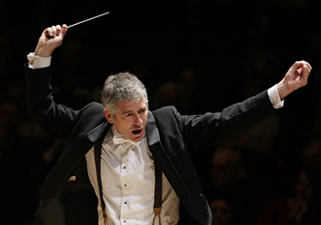Meymandi Concert Hall was packed with appreciative music lovers who heard the North Carolina Symphony deliver a world-class performance of Symphony No. 3 in D Minor by Gustav Mahler (1860-1911). I first heard this inspired, vast work twenty-five years ago in Duke University’s Page Auditorium in a joint NCS-Winston-Salem Symphony concert lead by Peter Perret. Meymandi Concert Hall is an ideal venue for this work with its demands for women’s chorus, an elevated boys’ choir, and off-stage instrumentalists. The work displayed the phenomenal artistic refinement of our state orchestra under current Music Director Grant Llewellyn.
Mahler’s Symphony No. 3 was composed during the summers of 1895 and 1896 at his retreat in Steunbach-am-Attersee in the Austrian mountains while he was free from his active conducting duties in Hamburg, Germany. Conductor Bruno Walter’s Gustav Mahler provides a fascinating account of the then 18-year-old author’s summer spent as the composer’s assistant in 1896.
Mahler originally had elaborate titles for each of the six movements of the work, reflecting “Nature as a Whole” as his inspiration. The huge first movement, lasting over 33 minutes, was called “Pan awakes: summer marches in.” The four next movements, all shorter, were titled: “What the flowers in the meadow tell me,” “What the animals in the woods tell me,” “What the night tells me (Mankind),” and “What the morning bells tell me (Angels).” These four sections run about ten minutes each. The more-than-twenty-minute-long finale, “What love tells me,” is one of the composer’s magnificent adagios; it builds toward an awe-inspiring climax. A planned seventh movement, ”The heavenly life (What the child tells me),” was set aside and became the finale of his Fourth Symphony. Mahler’s first four symphonies are known as his Wunderhorn symphonies because he either set texts from Das Kneben Wunderhorn, a collection of German folk-poems and songs to which he had composed Lieder, or used the song melodies instrumentally.
The Meymandi stage was well-filled with all the extra musicians Mahler demands for the Third Symphony. Nine French horns were among the doubling or better of the brass and woodwinds along with extra strings and a pair of harps. Members of the North Carolina Master Chorale Women’s Choir, prepared by director Alfred E. Sturgis, were seated above and behind the orchestra. Higher still, in the upper boxes on either side of the stage, were the members of the Raleigh Boychoir, prepared by director Robert Unger, split and facing each other antiphonally. Extra tubular bells were with the right hand group, and each box had an assistant conductor helping Llewellyn keep them precisely integrated. A door, ajar behind the double basses on the left, allowed the distant sounds of off-stage instruments – a snare drum and a flugelhorn, among others – to be heard.
Mahler was a master conductor who marked his scores in extreme detail, leaving few questions about his intentions. Llewellyn met all the demands as he held these large forces together over the more than 90-minute span, carefully molding each section within an overall vision. The dynamic range of the work is enormous, from the shattering massed fff involving nine French horns in the opening and the almost thundering low strings soon after to periods of hushed delicacy more breathed than whispered, such as the almost-more-felt-than-heard pppp timpani beats in this movement. Concertmaster Brian Reagin had superbly played solos in about every movement. The almost concerto-length trombone solos of the first movement were delivered magnificently by principal player John Ilika, as was its return in the finale. Principal horn Rebekah Daley delivered her many important solos and duets with other participants resplendently. Her expanded nine-member section gave a jaw-dropping performance. The raised bells of the horns were per Mahler’s instructions, as were those of the superb clarinet family that recalled the composer’s klezmer influences. Principal oboist Melanie Wilsden delivered her many solos with exemplary style and tone, not least the rather oriental-sounding oboe glissando in the fourth movement, the whole of which Deryck Cooke called “one of the stillest things in music.” The important, extended off-stage solo fügelhorn solo was dreamingly delivered by trumpeter Paul Randall. The desired distancing effect was perfectly created. Other fine solos by section principals were given by Michael Schultz, English horn, Anne Whaley Laney, flute, Elizabeth Lundsford, piccolo, Andrew Lowy, clarinet, and Paul Randall, trumpet. One is tempted to list the entire roster!
The important solo vocal and choral portions came off beautifully with fine diction from all involved. Mezzo-soprano Susan Platts has a firm lower range that reminds me of that famous Mahler singer Maureen Forrester. Platts’ rich tone and dark color was the icing for her Lieder-like clear delivery of the composer’s text. The North Carolina Master Chorale Women’s Choir delivered a fine, professional-quality performance. The challenge of the wide separation between the two sections of the Raleigh Boychoir was overcome, and they were excellent in the fifth movement. One thing I had never noticed on recordings was an important touch at the end, a pair of boys singing with solo woodwinds.
This run of three concerts (the first in Chapel Hill) was not to be missed! It will be memorable across the decades and well worth searching for if it is broadcast via public radio. Bravo to everyone involved!
The symphony will be repeated May 10 in the same venue. For details, see the sidebar.












